
Campaign Automation Services That Drive Conversions
“We’ll automate your campaigns” – this is the pitch every B2B brand hears.
But what most businesses get is a string of templated emails, misfired triggers, and a whole lot of pipeline silence.
The real problem today is that campaign automation services stop at execution. No real funnel logic. No CRM syncing. No behavior-based triggers. And definitely no alignment with sales goals.
So, what’s the solution? A strategy-first approach to B2B campaign automation that performs. Built for conversions, built to scale, and built with your buyers in mind.
Let’s break down what true campaign automation services look like.
1. Start With Revenue
The question isn’t “What email do we send next?” It’s “What do we want to convey and why?”
Real marketing automation for conversions begins with a clear revenue goal, like:
- More demos
- Product activations
- Upsells
- Retention
From there, you map user journeys backward: deciding touchpoints, channels, and logic based on what drives those outcomes.
But is campaign automation only for top-of-funnel? No. Mid- and bottom-of-funnel journeys like sales reactivation, pricing intent, or expansion plays can and should be automated too.
2. Segmentation That Goes Beyond the Obvious
You can’t convert what you don’t understand. Segmenting based on surface-level traits like company size or job title isn’t enough. Today’s leading tools like HubSpot campaign automation, Customer.io, and Marketo allow dynamic segmentation based on:
- On-site behaviors
- Email interactions
- Funnel stage
- Tech stack
- Industry trends
But how granular should segmentation be? As granular as your sales process. The more tailored the content and cadence, the higher your conversion lift.
3. Multi-Channel Campaigns or Nothing
Are you relying on email alone? If yes, you understand that buyers today move across platforms. Yes, multi-channel automation. So, your campaigns should too.
Modern campaign automation ties together:
- LinkedIn ad retargeting
- In-app messages and pop-ups
- WhatsApp or SMS nudges
- Contextual landing pages
- Sales rep task automation
And can you manage all this without adding tools? Yes. Most tools now support native or easy integrations, like HubSpot’s LinkedIn Ads sync or WhatsApp via Twilio. More tools don’t mean more pipeline. You just need to implement smarter orchestration.
4. CRM Integration Is Mandatory
If your campaigns run on one platform and your CRM runs on another, you’re leaking leads.
CRM-integrated campaigns ensure:
- Every touchpoint is logged
- Lead status updates in real-time
- Sales is notified the moment intent spikes
- Deal stages move automatically
With automated lead routing in place, new leads are instantly assigned to the right rep based on territory, funnel stage, or product fit. So, there will be zero delay in follow-up.
5. Automated and Instant Sales Enablement
Automation doesn’t stop at marketing. Your sales team needs real-time insights too. So, align marketing with sales using:
- Instant alerts when high-intent actions happen
- Pre-call summaries from lead-nurturing campaigns
- Battlecards delivered automatically
- Tasks are auto-assigned in CRM
This helps sales close faster. After all, reps save time, prioritize high-intent leads, and get the right content at the right moment without chasing marketing.
But isn’t this more of a sales ops thing? It’s both. Modern marketing-sales alignment means joint ownership of pipeline acceleration.
6. Optimize With Attribution, Not Gut Feel
Campaigns shouldn’t run blind. You need visibility into:
- Which channel drove the conversion
- Which asset accelerated the deal
- Where leads drop off
Modern attribution tools offer visual dashboards, UTM tracking, and multi-touch modeling to answer the ultimate question: Is this campaign driving revenue or not?
Fix Lead Routing and Attribution with RevOps-Driven Campaign Automation Services
B2B campaign automation saves time and scales impact. When done right, it connects every moving part of your funnel into one powerful, conversion-focused engine.
That means:
- A funnel-first automation strategy
- Segmentation based on behavior and buyer stage
- Multi-channel journeys across email, ads, and messaging
- CRM-integrated lead flows and sales alerts
- Internal workflows that empower your sales team
- Real-time attribution to track what’s actually working
When all of that is aligned with revenue goals, automation performs.
Want campaign automation that actually drives conversions? Talk to us about building one that works.




